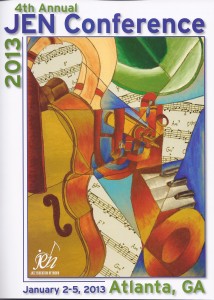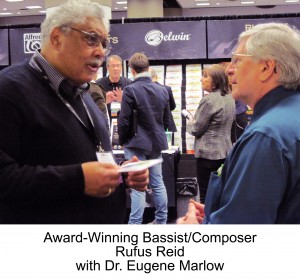The Jazz Education Network (JEN)—a re-imagining of the International Association for Jazz Education (IAJE) that went belly-up in 2008—held its fourth annual conference in Atlanta, GA that ended this last Saturday. According to current JEN President Andrew Surmani, the 4th Annual JEN Conference offered “. . . 85 concerts on 5 performance stages, featuring school groups of all ages as well as professional ensembles, [and] 74 clinics in 6 clinic rooms. . . “There were 86 exhibitors. The theme of the conference was “Networking the Jazz Arts Community . . . from Local to Global.”
The JEN office projected attendance of 3,000 (more or less). However, judging by the number of available seats in the Hyatt Regency’s (Peachtree Center in downtown Atlanta) 3,200 seat (theatre style) Centennial Ballroom and the consistent paucity of conference attendees drifting through the exhibits area, the number of conference attendees “felt” closer to 2,000!
Here’s the rub. The American economy is just beginning to recover. Travel budgets (including hotel accommodations) at corporations and educational institutions have been curtailed. With this as macro context, the JEN leadership scheduled this year’s annual conference just two days 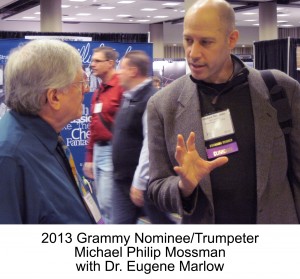 after the beginning of the new-year. True, January for most higher education professionals is a period between semesters, but not so for high school educators. Second, while the likes of saxophonist virtuoso Bob Minzter, award-winning composer/bassist Rufus Reid, and 2013 Grammy-nominee trumpeter/composer Michael Mossman were in attendance, the number of marquee name jazz performers was minimal.
after the beginning of the new-year. True, January for most higher education professionals is a period between semesters, but not so for high school educators. Second, while the likes of saxophonist virtuoso Bob Minzter, award-winning composer/bassist Rufus Reid, and 2013 Grammy-nominee trumpeter/composer Michael Mossman were in attendance, the number of marquee name jazz performers was minimal.
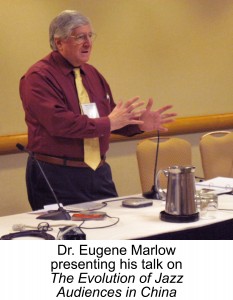 Moreover, while the ostensible theme of the conference just concluded was “. . . from Local to Global” of the 74 clinics only seven dealt with Global: “Moña-based Afro-Cuban Improvisational Concepts for Horn Players,” “Nilson Matta: Samba Meets Jazz,” “Millikin University Latin Jazz Project with Nester Torrres,” “SoundsGlobal with John Fedchock and Rick DiMuzio,” “Committed Artists for Cultural Advancement (South Africa) Music Ensemble,” “Canta Brasil – Brazilian Jazz Singing Master Class,” and my own clinic “The Evolution of Jazz Audiences in China.”
Moreover, while the ostensible theme of the conference just concluded was “. . . from Local to Global” of the 74 clinics only seven dealt with Global: “Moña-based Afro-Cuban Improvisational Concepts for Horn Players,” “Nilson Matta: Samba Meets Jazz,” “Millikin University Latin Jazz Project with Nester Torrres,” “SoundsGlobal with John Fedchock and Rick DiMuzio,” “Committed Artists for Cultural Advancement (South Africa) Music Ensemble,” “Canta Brasil – Brazilian Jazz Singing Master Class,” and my own clinic “The Evolution of Jazz Audiences in China.”
So far JEN has held annual conferences in New Orleans, LA (2010), St. Louis, MO (2011), Louisville, KY (2012), and Atlanta, GA (2013). The next JEN Conference (January 8-11, 2014) is planned for Dallas, TX.
I had been a long-standing member of the IAJE, attending conferences in Boston, Chicago, New Orleans, Anaheim, Atlanta, Toronto, and New York. So far, though, other than New Orleans, it seems the JEN leadership is content to locate its annual conferences in cities that are not centers of jazz performance or education. However, these locations are closer to the small to medium-sized educational institutions that provide jazz education in local and regional markets.
Ironically, several of the exhibitors were the larger, internationally known educational institutions: the Jazz Arts Program at the Manhattan School of Music, the New England Conservatory, the Berklee College of Music, the Brubeck Institute, the Florida International University School of Music, and the University of North Texas, among others.
This is just a guess, albeit an educated guess: the IAJE went big—big cities, big names in jazz (both domestic and international), big concerts, big money—and then it went bankrupt; so far, JEN has gone medium-sized—medium-sized cities, medium-sized names in jazz (many just starting out or regionally well known), and medium-sized money—much of the labor based on volunteer talent.
With IAJE now just a fading memory, perhaps the JEN leadership has it right—or perhaps it needs to find a more middle ground. With the exception of New Orleans, St. Louis, Louisville, and Atlanta are not hotbeds of jazz performance or innovation. If I’m wrong about this, please let me know. The center of the American jazz world is New York City: there are major clubs here, large-scale and indie labels, many jazz journalists, and jazz education programs. New York City is also an international city that fosters the evolution of world music of which jazz is a part.
Similar cities are Boston, Chicago, San Francisco, and Los Angeles. Yes, there are many, many more high school and college level jazz programs outside cities such as New York, but there is a reason why jazz musicians gravitate to cities like New York: it is a gathering place, a networking place for those motivated to move the music forward, both in terms of the music and audience development. Sooner or later the JEN leadership has to reconcile itself to the fact that Southern cities—including New Orleans–are not centers of jazz evolution.
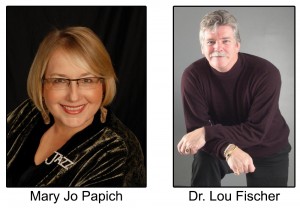 What the JEN leadership has done to date is highly commendable. Jazz educators like Mary Jo Papich and Dr. Lou Fischer—the co-founders of JEN—have done a remarkable job taking the ashes of the IAJE debacle and Phoenix-like giving birth to a new organization that serves the needs of jazz educators, on the one level, and the longer-term needs of the jazz business, on the other.
What the JEN leadership has done to date is highly commendable. Jazz educators like Mary Jo Papich and Dr. Lou Fischer—the co-founders of JEN—have done a remarkable job taking the ashes of the IAJE debacle and Phoenix-like giving birth to a new organization that serves the needs of jazz educators, on the one level, and the longer-term needs of the jazz business, on the other.
But JEN is clearly in the early stages of its development. It has many supporters (including myself) and reasonable goals. But if it truly means to develop audiences for jazz (among its several missions), sooner rather than later it must put itself on a larger stage.
Please write to me at meiienterprises@aol.com if you have any comments on this or any other of my blogs.
Eugene Marlow, Ph.D.
January 7, 2013
© Eugene Marlow 2013


